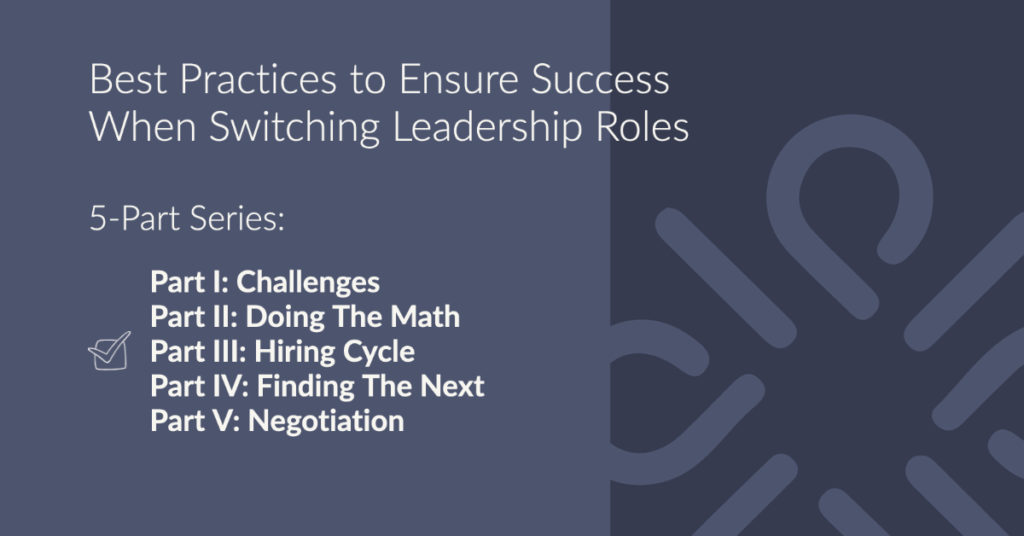Part III – The Hiring Cycle is part of a five-part series
In Part II of this series, we shared ideas around how you can soften the impact of switching roles to compensation by doing the math before switching leadership roles. This article will explore an additional crucial element; the hiring cycle and estimated time required to find the right next position.
The time associated with finding a new leadership role is generally more significant than the time associated with finding a lower-level position. Several factors cause an increase in the timeframe, including:
- Fewer available positions for top-level roles
- Considerations of what goes into finding the right opportunity
- Geographic demands for your expertise
- Increased number of decision-makers involved in the hiring process
- Negotiations based on compensation requirements
These factors may leave you wondering: what is the typical hiring cycle time frame for a marketing leadership role? The short answer is that there is no clear answer. But, let’s explore this idea of the hiring cycle further.
Executive Hiring Cycle
The U.S. Department of Labor reports a one month average for each $10,000 in income earned (e.g., if your salary is $150,000, on average, it may take you 1.25 years to find a new position, from the start of your search to onboarding at a new company). With that said, hiring cycles can vary greatly (I’ve seen ranges from just a few months to more than a year in some cases).
Keep in mind that searching for a new position takes time and effort. If you’re employed, finding a new role can take longer than if you’re unemployed simply because you don’t have the time to dedicate yourself to a full-time search.
But, finding an exciting opportunity is only the start. After you find a role you’re interested in, there are other important parts of the process.
To help you prepare for the entire process, the following are examples of steps within the hiring process along with timing estimations for each step.
Interviewing
In 2017, Glassdoor.com reported that the average interview process in the U.S. lasted 23.8 days. For executives, the company size, the number of stakeholders, and company procedures can elongate that number in the hiring cycle.
Because leadership roles are highly paid and have a significant impact on the company, the hiring process often requires additional steps.
The impact of a “bad hire,” especially in a leadership role, can have long-term, far-reaching consequences. Because of the need to “be sure,” leadership candidates should expect anywhere from 2-6 rounds of interviews with several decision-makers and key stakeholders (e.g., C-suite, Board of Directors, Peers, direct reports).
References
Checking references is no small part of the hiring cycle – especially when it comes to making a leadership hire. For leadership roles, potential employers will spend 10-15 hours contacting and speaking with references. Since reference checking is such a fundamental aspect of ensuring a “good hire,” organizations will often check references before moving to the next part of the hiring process.
Background Check / Assessments
Sometimes companies rush leadership-level candidates through the background check process. However, when a company invests in an expensive hire who will significantly impact the organization, they perform more than a standard background check.
According to the human resources platform, SHRM, alongside the usual primary screening, executive screening often includes additional vetting such as:
- Professional licenses
- Social media searches
- Credit reports
- Extensive reputational searches
- Litigations involving the candidate at the state and federal level
- Affiliations, board memberships, or corporate ties that may pose conflicts of interest
The usual employment background check takes about one week to complete. However, some of these additional screening items may prolong the background check completion date and impact the overall hiring timeframe.
Offers & Negotiations
Receiving a job offer is always a good feeling as it indicates the company has selected you to join their team. And receiving a perfect job offer is an even better feeling. The receipt of an offer is usually one of the last pieces in the career search cycle, but not always.
Similar to how a candidate interviews a company while a company is interviewing candidates, you should take some time to examine how the offer aligns with your requirements when you receive the job offer.
You can always negotiate if the original offer does not align with your needs for switching roles.
Later in this series (Part V), we’ll share negotiation strategies that use a holistic approach and explore all financial aspects within the total compensation offer.
The one critical item we hope you take away from this article is that the hiring cycle can be lengthy. One way you can take ownership of your timeline is to enlist the help of a recruiter. If you do work with a recruiter, be transparent with them about ideal transition dates and how those dates will impact your current compensation.
Read the entire series –
Parts I: Challenges | II: Doing the Math | III: Hiring Cycle | IV: Finding the Next | V: Negotiation
Looking to connect regarding new opportunities or a hiring need? Contact us today!


